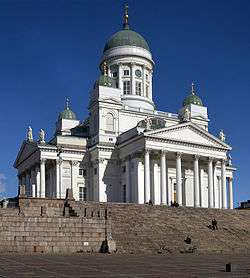Helsinki Cathedral
| Helsinki Cathedral | |
|---|---|
|
Helsingin tuomiokirkko, Suurkirkko (Finnish) Helsingfors domkyrka, Storkyrkan (Swedish) | |
 Helsinki Cathedral | |
| 60°10′13″N 024°57′08″E / 60.17028°N 24.95222°E | |
| Location | Helsinki, |
| Country | Finland |
| Denomination | Evangelical Lutheran Church of Finland |
| Website |
tuomiokirkko |
| History | |
| Dedication | St Nicholas |
| Architecture | |
| Status | Cathedral |
| Architect(s) | Carl Ludvig Engel; later altered by Ernst Lohrmann |
| Completed | 1852 |
| Specifications | |
| Capacity | seats 1,300 |
| Administration | |
| Diocese | Helsinki |
| Clergy | |
| Bishop(s) | Irja Askola |
Helsinki Cathedral (Finnish: Helsingin tuomiokirkko, Suurkirkko; Swedish: Helsingfors domkyrka, Storkyrkan) is the Finnish Evangelical Lutheran cathedral of the Diocese of Helsinki, located in the neighborhood of Kruununhaka in the centre of Helsinki, Finland. The church was originally built from 1830-1852 as a tribute to the Grand Duke of Finland, Tsar Nicholas I of Russia. It was also known as St Nicholas' Church until the independence of Finland in 1917.
Description

A distinctive landmark in the Helsinki cityscape, with its tall, green dome surrounded by four smaller domes, the building is in the neoclassical style. It was designed by Carl Ludvig Engel as the climax of his Senate Square layout: it is surrounded by other, smaller buildings designed by him.
The church's plan is a Greek cross (a square centre and four equilateral arms), symmetrical in each of the four cardinal directions, with each arm's façade featuring a colonnade and pediment. Engel originally intended to place a further row of columns on the western end to mark the main entrance opposite the eastern altar, but this was never built.
History
The cathedral was built on the site of the smaller Ulrika Eleonora Church, which was dedicated to its patroness, Ulrika Eleonora, Queen of Sweden. A facsimile of this church, made entirely from snow, was constructed on Senate Square in the early 2000s. Helsinki Old Church was built between 1824 and 1826 in nearby Kamppi to serve the parish while the Ulrika Eleonora Church was being demolished and until the consecration of the new cathedral.
The building was later altered by Engel's successor Ernst Lohrmann, whose four small domes emphasise the architectural connection to the cathedral's model, Saint Isaac's Cathedral in St. Petersburg. Lohrmann also erected two free-standing bell towers, as well as larger-than-life sized zinc statues of the Twelve Apostles at the apexes and corners of the roofline.[1] The altarpiece was painted by Carl Timoleon von Neff and donated to the church by emperor Nicholas I.[2] The cathedral crypt was renovated in the 1980s by architects Vilhelm Helander and Juha Leiviskä for use in exhibitions and church functions; Helander was also responsible for conservation repairs on the cathedral in the late 1990s.
Today, the cathedral is one of Helsinki's most popular tourist attractions. More than 350,000 people visit the church each year, some to attend religious events, but mostly as tourists. The church is in regular use for services of worship and special events such as weddings.
Gallery
- Helsinki Lutheran Cathedral, Finland
 The façade fronted by a statue of Emperor Alexander II of Russia.
The façade fronted by a statue of Emperor Alexander II of Russia. Helsinki Cathedral at night.
Helsinki Cathedral at night.- Market Square; Helsinki Cathedral is in the centre of the image.
 The cylindrical pulpit.
The cylindrical pulpit.
In popular culture
The opening sequence of the music video for "Sandstorm" by Darude was filmed on Senate Square, prominently featuring the Cathedral in the background.
See also
Notes
- ↑ Cast by the prominent firm of S. P. Devaranne, Berlin, and set up in 1852, according to Carol A. Grissom, Zinc sculpture in America, 1850–1950 2009:587.
- ↑ "HelsingforsDomkyrka" (in Swedish). Uppslagsverket Finland. Retrieved 19 February 2013.
External links
-
 Media related to Helsinki Cathedral at Wikimedia Commons
Media related to Helsinki Cathedral at Wikimedia Commons - Panoramic view of Helsinki Cathedral